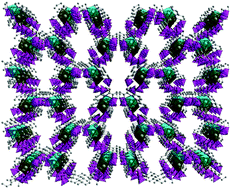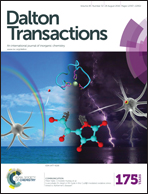Functionalized phosphonates as building units for multi-dimensional homo- and heterometallic 3d–4f inorganic–organic hybrid-materials†
Abstract
Using the multifunctional ligand H4L (2,2′-bipyridinyl-5,5′-diphosphonic acid), a new family of inorganic–organic hybrid-materials was prepared. The ligand shows a very high flexibility regarding the coordination mode, leading to a large structural diversity. The compounds 1a, 1b ([M(H2L)(H2O)4]·2.5H2O; M = Co2+ (a), Ni2+ (b)), 2 ([Gd2(H2H′L)2(H2H′2L)(H2O)6]Cl4·14H2O), 3a, 3b, 3c ([MCo(III)(H2L)3(H2O)2]·6.5H2O; M = Gd3+ (a), Dy3+ (b) and Tb3+ (c)), and 4 ([GdNi(II)(H2L)3(H2O)3]NaCl·6H2O) were isolated and characterized with single crystal X-ray diffraction. Depending on the used metal ions and on the stoichiometry, either discrete entities (0D), extended 2D layers or 3D frameworks were obtained. In contrast to the general approach in phosphonate chemistry, the compounds were prepared without hydrothermal synthesis, but under ambient pressure. Variable temperature magnetic measurements were carried out to determine the magnetic properties.


 Please wait while we load your content...
Please wait while we load your content...